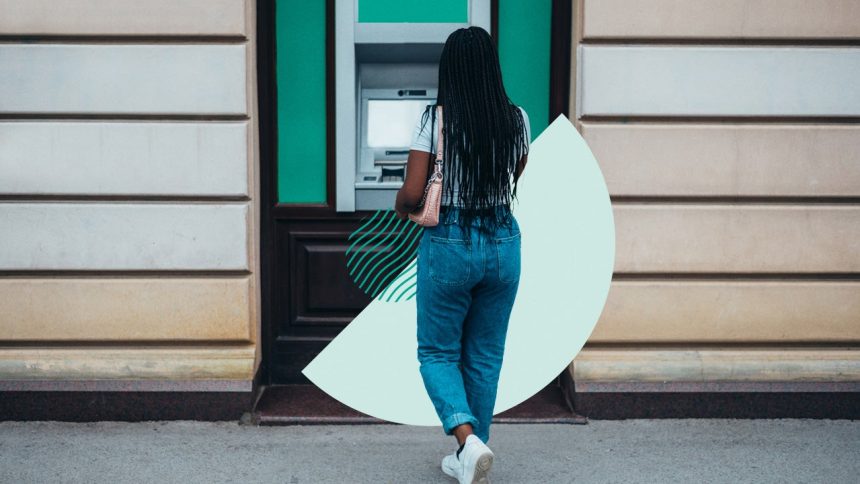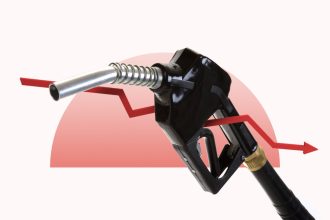zamrznutitonovi/Getty Images: Illustration by Issiah Davis/Bankrate
ATM fees cost you $4.77 per out-of-network transaction on average, according to Bankrate’s checking account and ATM fee study. This represents a record high, with fees increasing steadily over the past decade. Using simple strategies to avoid these charges could save you over $100 annually if you typically make two out-of-network ATM withdrawals per month.
Key takeaways
- It pays to avoid out-of-network ATM fees, with the current average total fee having climbed to a record high of $4.77.
- When you need cash but there’s no in-network ATM nearby, one option is to get cash back when making a purchase at a grocery store or other retailer, although some major chains may levy a small fee for this service.
- Other ways to avoid ATM fees include finding a bank account that reimburses such fees or opting for digital payments over cash transactions when possible.
1. Use in-network ATMs
When you use an out-of-network ATM, you typically face two separate charges: your bank’s fee (averaging $1.58) plus the ATM owner’s surcharge (averaging $3.19). Combined, you could pay $7.50 or more just to access your own money.
An ATM owned by your bank or within its partnered network (such as Allpoint or MoneyPass) won’t charge out-of-network fees. Most banks provide mobile apps or websites with ATM locators to help you find nearby fee-free machines.
If you’re not willing to switch banks, understand how your current bank’s ATM network works. Just because their name isn’t on an ATM doesn’t mean it’s not fee-free. Most banks, even smaller ones, have an app that allows you to find ATMs in your network. If not, ask them if they have a preferred way to find ATMs within the network.
— R.J. Weiss, CFP, founder of The Ways To Wealth
Related: Compare Bankrate’s best checking accounts to find options with extensive ATM networks.
2. Get cash back at retailers
When checking out at grocery stores or eligible retailers, you can often get cash back with your purchase by paying with your debit card and entering your PIN. The card reader will prompt you to select the cash back amount, which gets withdrawn from your linked account.
Some retailers may charge small fees for this service:
- Dollar General, Dollar Tree and Kroger may charge $0.50 to $3.50 depending on the store and withdrawal amount
- Cash back limits typically range from $20 to $300 per transaction
- Most major retailers offer this service free of charge
While convenient, cash back at retailers may carry higher security risks compared to using ATMs at bank branches. Card skimmers are more commonly found on non-bank ATMs or machines inside convenience stores.
3. Opt for digital payments
In many situations where you’d traditionally use cash, digital alternatives can eliminate ATM visits entirely. Payment apps like Venmo or Zelle are accepted for tips at salons, restaurants and service providers.
Note on Venmo ATM fees: If you have a Venmo debit card, you’ll pay $2.50 per ATM withdrawal within the U.S., plus any fees charged by the ATM owner. MoneyPass ATMs are fee-free for Venmo debit card holders.
Always confirm with merchants beforehand that your preferred payment app is accepted.
4. Make larger, less frequent withdrawals
When you must use out-of-network ATMs, minimize fees by withdrawing larger amounts in single visits rather than making multiple small withdrawals.
However, be aware of ATM withdrawal limits, which typically range from $500 to $1,000 per day depending on your bank and ATM. Planning ahead can help you maximize each withdrawal within these limits.
Money tip:
Combining strategies like using in-network ATMs and high-yield checking accounts can help maximize your savings beyond just avoiding ATM fees.
5. Choose a bank that reimburses ATM fees
Many banks and credit unions, particularly online-only institutions, offer checking accounts that reimburse out-of-network ATM fees. This strategy can be especially valuable if you travel frequently or live in areas with limited access to your bank’s ATM network.
Banks with ATM fee reimbursement
|
Bank name |
Maximum monthly reimbursement |
Eligible account type |
Other account benefits |
Any limitations or restrictions |
|
Alliant Credit Union |
Up to $20 per statement cycle |
Savings or checking accounts |
Access to 80,000+ fee-free ATMs, no account opening or maintenance fees |
Credit union membership required |
|
Ally Bank |
$10 |
Spending Account |
No overdraft or maintenance fees, early direct deposit access |
International transactions may be subject to a 1% fee |
|
Axos Bank |
Unlimited domestic reimbursements |
Essential Checking, Rewards Checking and Cashback Checking accounts |
No monthly maintenance fees, 24/7 customer support |
No Zelle access |
|
Charles Schwab |
Unlimited ATM fee reimbursements |
Investor Checking account |
No monthly service fees, overdraft fees, or foreign transaction fees |
Must open brokerage account |
|
LendingClub |
Unlimited ATM fee reimbursements |
Rewards Checking |
Earns 1% cash back on qualified debit card purchases |
Multiple requirements for rewards |
|
Navy Federal Credit Union |
Up to $10 per statement cycle |
Free Easy Checking |
No monthly service fees or minimum balance requirements |
Must set up direct deposit or make 20+ monthly transactions; credit union membership required |
How to find fee-free ATMs
Most banks provide ATM locator tools through their mobile apps or websites, showing nearby machines on an interactive map. You can also use:
ATM fees vary significantly by location. Cities with the highest average fees include Atlanta ($5.33), San Diego, Phoenix, Detroit, and Cleveland (all above $5.00). Boston has the lowest average fees at $4.16.
For frequent international travelers, some banks also offer international ATM fee reimbursements. Charles Schwab’s Investor Checking Account, for example, reimburses unlimited ATM fees worldwide with no foreign transaction fees.
Next steps: Use Bankrate’s guide to mobile banking to find banks with mobile apps that make locating in-network ATMs easier.
Bottom line
Using an out-of-network ATM twice a month and paying the average total withdrawal fee of $4.77 would cost you $114.48 in fees annually. However, simple strategies like locating in-network ATMs can help you save.
There’s no single approach to eliminating ATM fees, but combining multiple strategies provides the best results. Start by understanding your bank’s ATM network and using fee locator tools. When possible, embrace digital payment methods to reduce cash needs entirely. If you frequently encounter out-of-network ATMs due to travel or location constraints, consider switching to a bank that offers ATM fee reimbursements.
Learn more: Discover Bankrate’s best checking accounts that minimize fees and maximize benefits.
FAQs about ATM fees
Why we ask for feedback
Your feedback helps us improve our content and services. It takes less than a minute to
complete.
Your responses are anonymous and will only be used for improving our website.
Help us improve our content
Read the full article here
















